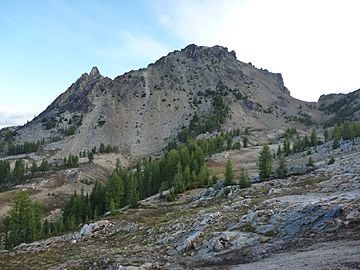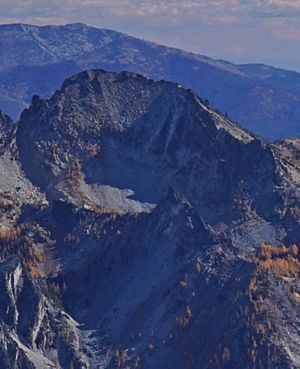Pinnacle Mountain (Washington) facts for kids
Quick facts for kids Pinnacle Mountain |
|
|---|---|

Pinnacle Mountain, south aspect
|
|
| Highest point | |
| Elevation | 8,400 ft (2,600 m) |
| Prominence | 1,720 ft (520 m) |
| Isolation | 2.23 mi (3.59 km) |
| Parent peak | Emerald Peak 8,404 ft |
| Geography | |
| Location | Chelan County Washington, U.S. |
| Parent range | Chelan Mountains North Cascades Cascade Range |
| Topo map | USGS Pinnacle Mountain |
| Type of rock | hornblende quartz diorite, granodiorite |
| Climbing | |
| First ascent | 1948 Dwight Watson, Ken Fleming |
| Easiest route | class 3 scrambling South slopes |
Pinnacle Mountain is a large mountain in Washington state. It is about 8,400 feet (2,560 meters) tall. This mountain is made of a type of rock called granite. It has several peaks.
Pinnacle Mountain is found in the Chelan Mountains. This area is part of the Glacier Peak Wilderness in the North Cascades. The land is looked after by the Wenatchee National Forest.
According to Fred Beckey's climbing guide, the highest point of Pinnacle Mountain is 8,402 feet. It is the fourth-highest peak in the Chelan Mountains. It is also the 75th-highest mountain in all of Washington state.
The closest taller mountain is Saska Peak, about 1.9 miles (3.1 km) to the southeast. Emerald Peak is about 2.25 miles (3.6 km) to the east-southeast. Rain and melting snow from Pinnacle Mountain flow into the Entiat River and Chelan River.
Weather at Pinnacle Mountain
Most of the weather in this area comes from the Pacific Ocean. It moves northeast towards the Cascade Mountains. When these weather systems reach the North Cascades, the tall mountains push the air upwards. This causes the air to cool and drop its moisture. This moisture falls as rain or snow onto the Cascades. This process is called Orographic lift.
Because of this, the North Cascades get a lot of rain and snow. This is especially true during the winter months. In winter, the weather is often cloudy. However, during the summer, high-pressure systems over the Pacific Ocean become stronger. This often means there are clear skies and little to no clouds.
How Pinnacle Mountain Formed
Pinnacle Mountain is mostly made of rocks called granodiorite and hornblende quartz diorite. These rocks are part of a large body of igneous rock called the Cardinal Peak pluton.
The North Cascades have very rugged land. You can see jagged peaks, tall spires, long ridges, and deep valleys carved by glaciers. These different landforms and big changes in height happened because of geological events many years ago. These events also led to the different climates you find across the Cascade Range.
The Cascade Mountains started forming millions of years ago. This was during the late Eocene Epoch. At that time, the North American Plate was slowly moving over the Pacific Plate. This movement caused many volcanic eruptions. Glacier Peak, a large stratovolcano, started forming about 21.8 miles (35.1 km) west of Saska Peak.
Also, small pieces of the Earth's crust, called terranes, helped create the North Cascades. This happened about 50 million years ago.
During the Pleistocene period, which was over two million years ago, glaciers moved across the land many times. As they moved, they scraped away rock and left behind rock debris. The river valleys in this area have a "U"-shape. This shape was created by these recent glaciers.
The main forces that made the tall peaks and deep valleys of the North Cascades are:
- Uplift: When the land slowly rose up.
- Faulting: When cracks in the Earth's crust caused blocks of land to move.
- Glaciation: The action of large ice sheets.




